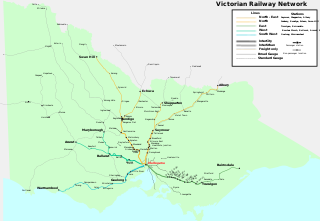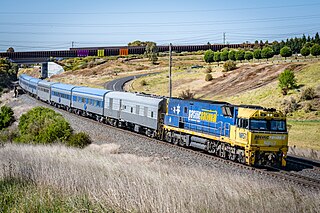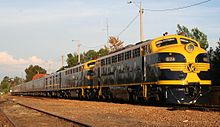
Rail transport in the Australian state of Victoria is provided by a number of railway operators who operate over the government-owned railway lines. The network consists of 2,357 km of Victorian broad gauge lines, and 1,912 km of standard gauge freight and interstate lines; the latter increasing with gauge conversion of the former. Historically, a few experimental 762 mm gauge lines were built, along with various private logging, mining and industrial railways. The rail network radiates from the state capital, Melbourne, with main interstate links to Sydney and to Adelaide, as well as major lines running to regional centres, upgraded as part of the Regional Fast Rail project.

The Overland is an interstate passenger train service in Australia, travelling between the state capitals of Melbourne and Adelaide, a distance of 828 km (515 mi). It first ran in 1887 as the Adelaide Express, known by South Australians as the Melbourne Express. It was given its current name in 1936. Now operated by private company Journey Beyond, the train undertakes two return trips a week. Originally an overnight train that stopped at large intermediate stations, it now operates during the day, stopping less frequently.

The Victorian Railways (VR), trading from 1974 as VicRail, was the state-owned operator of most rail transport in the Australian state of Victoria from 1859 to 1983. The first railways in Victoria were private companies, but when these companies failed or defaulted, the Victorian Railways was established to take over their operations. Most of the lines operated by the Victorian Railways were of 5 ft 3 in. However, the railways also operated up to five 2 ft 6 in narrow gauge lines between 1898 and 1962, and a 4 ft 8+1⁄2 instandard gauge line between Albury and Melbourne from 1961.
The North East railway line is a railway line in Victoria, Australia. The line runs from Southern Cross railway station on the western edge of the Melbourne central business district to Albury railway station in the border settlement of Albury-Wodonga, serving the cities of Wangaratta and Seymour, and smaller towns in northeastern Victoria.

The Victorian Railways X class was a mainline goods locomotive of the 2-8-2 'Mikado' type operated by the Victorian Railways (VR) between 1929 and 1960. They were the most powerful goods locomotive on the VR, aside from the single H class, H220, which was confined to the North East line, until the advent of diesel-electric traction, and operated over the key Bendigo, Wodonga, and Gippsland mainlines.

The A2 class was an express passenger locomotive that ran on Victorian Railways from 1907 to 1963. A highly successful design entirely the work of Victorian Railways' own design office, its long service life was repeatedly extended as the Great Depression and later World War II delayed the introduction of more modern and powerful replacement locomotives.
The Victorian Railways S class was a class of 4-6-2 express passenger steam locomotive operated by the Victorian Railways (VR) in Australia between 1928 and 1954. Built when the VR was at its zenith and assigned to haul the broad gauge-leg of its Melbourne to Sydney interstate express passenger services, the S class remained the VR's most prestigious locomotive class until the advent of diesel electric locomotives in the early 1950s.

The Victorian Railways H class was an express passenger steam locomotive operated by the Victorian Railways from 1941 to 1958. Intended to eliminate the use of double heading A2 class locomotives on The Overland services on the steeply graded Western line to Adelaide, wartime restrictions led to only one locomotive being built. Nicknamed Heavy Harry, H220 was the largest locomotive ever built in Australia and the largest non-articulated steam locomotive to run on Australian railways.

The N Class are a class of diesel locomotives built by Clyde Engineering in Somerton for V/Line between 1985 and 1987.

The Southern Aurora was an overnight express passenger train that operated between Australia's two largest cities, Sydney and Melbourne. First-class throughout, including the dining facilities, the Southern Aurora featured all-sleeper accommodation. The train first ran on 13 April 1962 after the opening of the North East standard gauge line from Melbourne to Albury, eliminating the break-of-gauge between the capital cities.

The S type carriages are a corridor-type passenger carriage used on the railways of Victoria, Australia. The first carriages were constructed by the Victorian Railways in 1937 for use on the Spirit of Progress, with additional carriages built for other trains until the mid-1950s.

The Inter-Capital Daylight was a passenger train that operated between Australia's two largest cities, Sydney and Melbourne from March 1956 until August 1991.

The Albury line is a regional passenger rail service operated by V/Line in Victoria, Australia. It serves passengers between the state capital of Melbourne and the regional cities of Benalla, Wangaratta, Wodonga, and the NSW border city of Albury.
The Victorian Railways (VR) of Australia and successors have utilised a number of different types of railway carriages and wagons for the supply of head end power to passenger trains on the Victorian railway network.

Sir Harold Winthrop Clapp KBE was a transport administrator who over the course of thirty years had a profound effect on Australia's railway network. In two decades as its Chairman of Commissioners, he revolutionised Victorian Railways, with unprecedented attention to customer service and innovations such as more powerful locomotives, air-conditioned carriages, and faster services culminating in the introduction of the flagship Spirit of Progress express train. Seconded to the Federal Government in World War II, he played a pivotal role in the manufacture of fighter aircraft in the defence of Australia. As Director-General of Australia's Land Transport Board, he presented a report on railway gauge standardisation that ultimately led to the eventual linking of all Australian mainland capital cities by a uniform track gauge.

The Victorian Railways' (VR) Royal Trains operated to transport members of the royal family on their numerous tours of Australia on the Victorian rail network. The same carriages were also used for a number of vice-regal trains for the governor-general of Australia and the governor of Victoria. The last Royal Train ran in 1988.

The AA class was an express passenger locomotive that ran on the Victorian Railways between 1900 and 1932. The largest, heaviest and most powerful 4-4-0 steam locomotive to run in Australia, it was the final development of this locomotive type in Australia.
The Sydney–Melbourne Express was an overnight intercapital passenger train service that operated between Australia's largest two cities, Sydney and Melbourne, between August 1986 and November 1993. Operated jointly by State Rail Authority and V/Line the name depended on the direction of travel, with the train nicknamed the 'Sex' or 'Mex'.
The Sydney Express was a passenger train which operated between Australia's two most populous cities, Melbourne and Sydney, between 1883 and 1937. The service commenced when the Victorian railway was extended across the Murray River to Albury to link with New South Wales' standard gauge line. The Sydney Express was superseded in 1937 by the Spirit of Progress, which also terminated at Albury until 1962, when the North East railway line was converted to standard gauge allowing it, and the new Southern Aurora to operate through to Sydney.





















